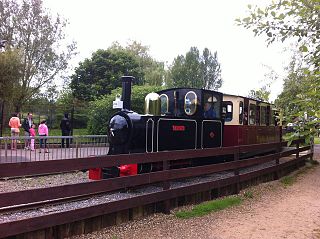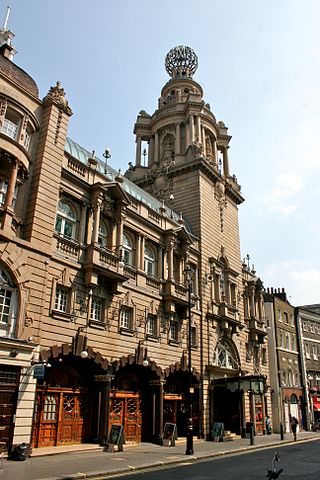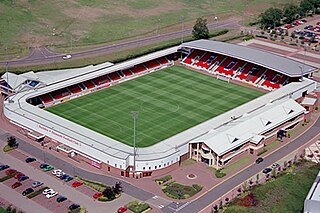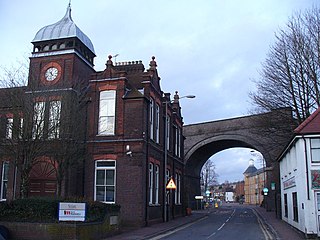
The Kettering Savoy (previously, Coliseum Theatre; subsequently, Ohio Theatre; also known as The Savoy) was a theatre and cinema in Russell Street, Kettering, Northamptonshire, England.

The Kettering Savoy (previously, Coliseum Theatre; subsequently, Ohio Theatre; also known as The Savoy) was a theatre and cinema in Russell Street, Kettering, Northamptonshire, England.
The Kettering Savoy was originally known as the Coliseum Theatre. It opened in 1910 in a building which had been built seven years earlier, but a fire gutted it in 1937. [1] The theatre was rebuilt and reopened on 21 May 1938 with a screening of the Hollywood film Big City (1937), starring Spencer Tracy and Luise Rainer, and a variety show on stage. Over the years, numerous stage productions were held in the theatre, and several prestigious actors appeared on stage here in their earlier careers. It was annexed by the Clifton Cinemas circuit on 25 August 1944, and the Northampton Repertory Company were based there between 1949 and 1951; it was described as the Northampton Repertory Theatre's outpost. [2] In 1951, a Lionel Hamilton production of The Romantic Young Lady , from the Spanish of Gregorio Martínez Sierra, [3] starring Jean Charlesworth, Peter Bell and Ronald Radd was put on at the Savoy. [4] In 1951, Jim Dale made his stage debut as a stand-up comedian at the theatre, [5] and was discovered there by Carroll Levis. [6]
The Savoy struggled to stay open as a theatre throughout the year and in April 1953, it was reported that stage shows would cease during the summer months and it would begin functioning as a cinema throughout the week as well as weekends, too. [7] The Kettering Savoy closed in 1986 but reopened as the Ohio Theatre. It eventually closed in 1997 when the new Odeon Multiplex was built in the town, and it subsequently fell into a highly dilapidated state with frequent vandalism. It was targeted in an arson attack on 16 September 2011, and was finally bulldozed down in June 2014. [1] A building with 23 one-room flats is planned to be built on the site. [8]
The Kettering Savoy had 1150 seats. The stage measured 43 by 23 feet (13.1 m × 7.0 m) in width and depth; its height was 60 feet (18 m). Grecian murals decorated the interior, with "concealed lighting and elaborated ventilation grills down the sides and above the rectangular proscenium." [1] There were seven dressing rooms and a band room. In 1968, it was split, with a small cinema of 485 seats, known as The Studio, and the stage becoming a bingo hall. Five years later, in 1973, the screen was split into two, dividing the cinema into Studio 1 and 2, with 160 and 140 seats respectively. [1]

Northampton is a town and civil parish in Northamptonshire, England. It is the county town of Northamptonshire and the administrative centre of the unitary authority of West Northamptonshire. The town is situated on the River Nene, 60 miles (97 km) north-west of London and 50 miles (80 km) south-east of Birmingham. Northampton is one of the largest towns in England; the population of its overall urban area was recorded as 249,093 in the 2021 census.

Northamptonshire is a ceremonial county in the East Midlands of England. It is bordered by Leicestershire, Rutland and Lincolnshire to the north, Cambridgeshire to the east, Bedfordshire, Buckinghamshire, Oxfordshire to the south and Warwickshire to the west. Northampton is the largest settlement and the county town.

The Savoy Theatre is a West End theatre in the Strand in the City of Westminster, London, England. The theatre was designed by C. J. Phipps for Richard D'Oyly Carte and opened on 10 October 1881 on a site previously occupied by the Savoy Palace. Its intended purpose was to showcase the popular series of comic operas of Gilbert and Sullivan, which became known as the Savoy operas.

Corby is a town and civil parish in the North Northamptonshire unitary authority area of Northamptonshire, England. It is located 23 miles (37 km) north-east of Northampton. From 1974 to 2021, the town served as the administrative headquarters of the Borough of Corby. At the 2021 Census, the built-up area had a population of 68,164 while the borough, which was abolished in 2021, had a population of 75,571 in 2021.

Kettering is a market and industrial town in the North Northamptonshire unitary authority area of Northamptonshire, England. It forms a civil parish called Kettering Town. Kettering is located 67 miles (108 km) north of London and 15 miles (24 km) north-east of Northampton, west of the River Ise, a tributary of the River Nene. The name means "the place of Ketter's people ".

East Northamptonshire was a local government district in Northamptonshire, England, from 1974 to 2021. Its council was based in Thrapston and Rushden. Other towns included Oundle, Raunds, Irthlingborough and Higham Ferrers. The town of Rushden was by far the largest settlement in the district. The population of the district at the 2011 Census was 86,765.

Wicksteed Park is a Grade II listed park in Kettering, Northamptonshire, England, which includes an amusement park within its grounds. The park is located in the south-east of Kettering, on the western edge of Barton Seagrave village. The park is owned by the Wicksteed Charitable Trust, with the amusement park being run by its trading subsidiary company Wicksteed Park Ltd.

The London Coliseum is a theatre in St Martin's Lane, Westminster, built as one of London's largest and most luxurious "family" variety theatres. Opened on 24 December 1904 as the London Coliseum Theatre of Varieties, it was designed by the architect Frank Matcham for the impresario Oswald Stoll. Their ambition was to build the largest and finest music hall, described as the "people's palace of entertainment" of its age.

The Cultural Quarter of the town Northampton, England, is a local council initiative to promote the area of the town centre which contains the theatre and museum. Part of it was referred to as Derngate, the name of a gate in the old town walls.

Kettering is a constituency in Northamptonshire represented in the House of Commons of the UK Parliament since 2005 by Philip Hollobone, a Conservative.

Nene Park was a sports stadium situated at Irthlingborough, Northamptonshire, England, along the bank of the River Nene, which could accommodate 6,441 spectators, with 4,641 seated and 1,800 standing. It formerly hosted football matches but at its time of demolition it was unused. The car park could hold 800 vehicles. From 1992 until the club's demise in 2011, it was the home ground of Rushden & Diamonds, having from 1969 been the home of predecessor Irthlingborough Diamonds. It became Kettering Town's home for 18 months, but the club left the venue in November 2012 to play at Corby, due to the costs of running the ground. Demolition of the ground began in late February 2017 and lasted approximately two and a half months.

Ronald Radd was a British television actor. He is perhaps best remembered for originating the role of Hunter in the television thriller series Callan. In 1971, he was nominated for a Tony Award for Abelard and Heloise.

Northampton St. John's Street was a railway station and the northern terminus of the Midland Railway's former Bedford to Northampton Line which served the English county town of Northampton from 1872 to 1939. Its closure came about as a cost-cutting measure implemented by the London, Midland and Scottish Railway which diverted services to the nearby Northampton Castle station. After closure the elegant station building was used as offices and the line for the storage of rolling stock; the site was cleared in 1960 to make way for a car park. The car park has now been built on and is the location of St Johns Halls of Residence for The University of Northampton.

The Wycombe Repertory Theatre, later referred to as the Tower Theatre and the Intimate Theatre, was a repertory theatre in High Wycombe, Buckinghamshire. It opened in 1946 and closed in 1958.

Royal & Derngate is a theatre complex in the Cultural Quarter of Northampton, England, consisting of the Royal Theatre, Derngate Theatre and the Northampton Filmhouse. The Royal was built by theatre architect Charles J. Phipps and opened in 1884. Ninety-nine years later in 1983, Derngate, designed by RHWL, was built to the rear of the Royal. Whilst the two theatres were physically linked, they did not combine organisations until a formal merger in 1999; they are run by the Northampton Theatres Trust. The Royal Theatre, established as a producing house, has a capacity of 450 seats and since 1976 has been designated a Grade II listed building; Derngate Theatre seats a maximum of 1,200 and is a multi-purpose space in which the auditorium can be configured for a variety of events including theatre, opera, live music, dance, fashion and sports. The Northampton Filmhouse, an independent cinema built to the side of the complex, opened in 2013.
Lionel Hamilton was an English theatre director and actor, director of the Northampton Repertory Company in Northampton, England. Much of his work was conducted at the Northampton Repertory Theatre and the Kettering Savoy in the late 1940s and 1950s.
Peter Bell was a British stage actor and producer. In 1951 he appeared opposite Jean Charlesworth and Ronald Radd in a Lionel Hamilton production of The Romantic Young Lady at the Kettering Savoy. He was employed by the Northampton Repertory Company in the early 1950s, but by 1953 had appeared to have moved on. His wife, Mary Honer, was involved with training young actors on stage in Northampton. In 1950, Bell and Jack Livesey produced youth productions of Stanley Houghton's comedy The Dear Departed and Ian Haly's farce The Crimson Coconut at Towcester Town Hall.
Owen Parker was a British industrialist, who served as Conservative MP for Kettering in 1922–23.

The Municipal Offices is a municipal building in Bowling Green Road in Kettering, Northamptonshire, England. The building is used as an area office for North Northamptonshire Council.

The Corn Exchange is a commercial building in the Market Place, Kettering, Northamptonshire, England. The structure, which was used as a cinema for much of the 20th century, currently accommodates a restaurant.